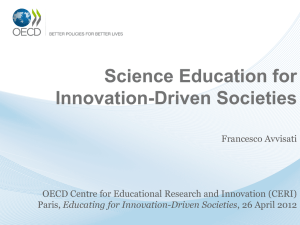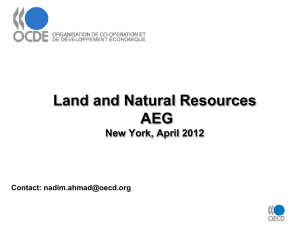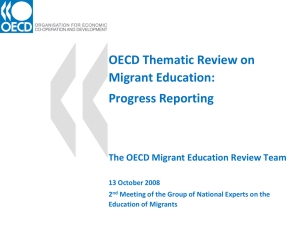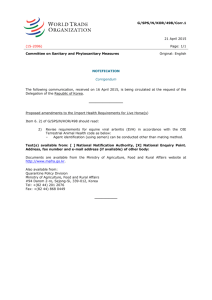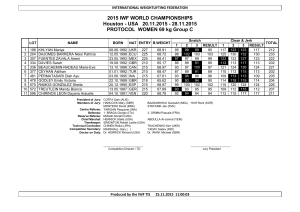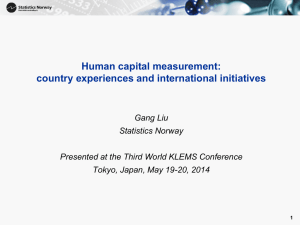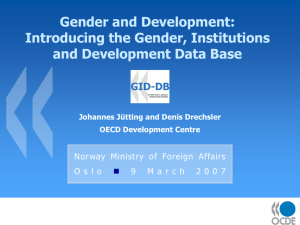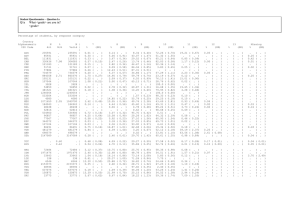Effective Teaching for Improving Students' Motivation
advertisement
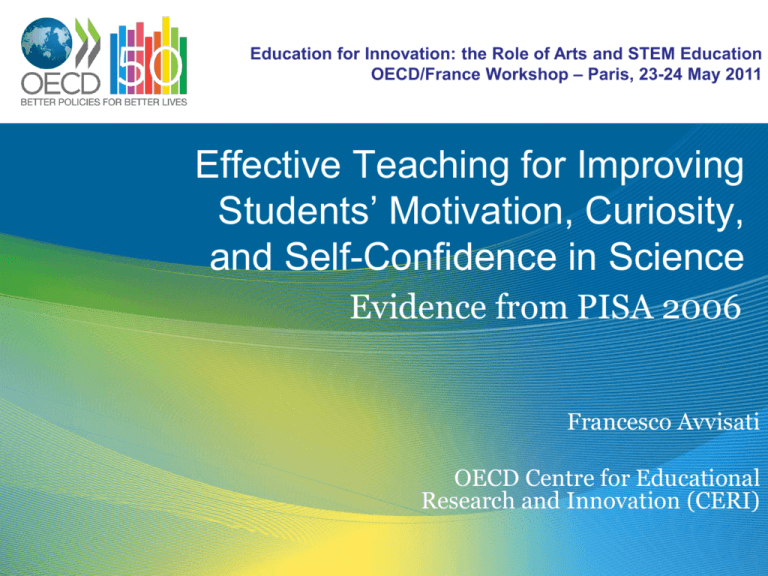
Education for Innovation: the Role of Arts and STEM Education OECD/France Workshop – Paris, 23-24 May 2011 Effective Teaching for Improving Students’ Motivation, Curiosity, and Self-Confidence in Science Evidence from PISA 2006 Francesco Avvisati OECD Centre for Educational Research and Innovation (CERI) Motivation Motivation Outline • PISA measures of behavioural skills • The paradox of international comparisons of interest, curiosity, and self-confidence – between and within-country evidence • Teaching activities’ effectiveness on students’ learning – within-country evidence PISA measures of behavioural skills • PISA Test – interest in science topics (“embedded”) • PISA Context Questionnaire – Enjoyment of science – Science self-concept – Science self-efficacy Part I THE TEST-SCORE / INTEREST PARADOX The Test-Score/Interest Paradox Interest in Science Topics 620 IDN MEX 600 BRA CHL 580 PRT 560 540 GRC RUS TUR ITA 520 500 480 460 FRA MAC DEU JPN HUN AUT LUX SVN EST POL BEL CHE CZE KOR IRL USA CAN NOR GBR AUS ISL NZL DNK SWE NLD SVK ISR HKG ESP FIN 440 380 400 420 440 460 480 500 Science Score 520 540 560 580 Youth Suicide Rate (15-24) The Test-Score/Interest Paradox A Logical Fallacy 25 KOR 20 HUN JPN BEL FIN FRA 15 AUT POL CZE CHE ISL NOR DNKSWE USA 10 AUS DEU NZL CAN IRL PRT LUX NLD ITA 5 ESP GBR MEX GRC 0 400 420 440 460 480 500 Science Score 520 540 560 580 -0.8 JPN KOR 0 -0.4 BRA MEX 0.8 RUS IDN SWE GBR GRC NOR FIN POL AUT CHE ISL EST SVK TUR ITA CHL USA SVN LUX CAN ISR DEU PRT 0.4 HKG MAC NLD HUN BEL IRL FRA DNK NZL CZE AUS ESP Authentic attitudes or fake postures? Science Self-Concept -1.2 • Social desirability bias? The Test-Score/Interest Paradox Robustness • Interest is less sensitive to cultural biases • Adding confounders: 0 -0.5 -1 0.5 HKG IDN MAC BRA RUS 0.3 IDN MAC HKG MEX HUN PRT USA EST TUR SVK CZE ITA ESP ISR GRC LUX AUT DEU BEL NZL NLD GBR IRL CHE FRA AUS CAN KOR SVN DNK JPN SWE FIN NOR ISL 0.6 BRA RUS 1 GBR SVN GRC CAN DEU FIN IRL AUS CHE LUX FRA DNK SWE NOR ISL JPN KOR -0.3 CHL POL 0 CHL USA PRT ISR ITA POL BEL NZL MEX TUR NLD SVK ESP CZE HUN AUT EST The Test-Score/Interest Paradox Interpretation within-school correlation of individual interest and scores -0.6 between-school correlation of average interest and scores The Test-Score/Interest Paradox Conclusion • Some school cultures (teaching cultures?) have diverging effects on interest and scores – High stake testing? (extrinsic motivation) – Low academic standards? – Teaching to the test, lack of cognitive activation? Japan, Germany, Korea, France – United States, Chile, Israel, Portugal Part II EFFECTIVE TEACHING Effective Teaching: Motivation • What teaching activities are associated with better test-scores? (subject-based competences) • What type of teaching develops motivation, curiosity and self-confidence the most? (behavioural competences) Effective Teaching: Data student reports on 4 clusters of activities • Interaction Collaboration and participatory exchanges • Application Drawing connections between school science and the outside world • Hands-on Guided activities around lab experiments • Investigation Autonomous student inquiries Effective Teaching: Data • example: focus on models & applications Effective Teaching: Methods Problems with interpreting correlations causally: • Pupils differ ex-ante (correlation might be spurious) – Control for observable individual and peer characteristics; control for reading scores. – Explore robustness across countries • Measurement error and reverse causality in reports of teaching activities – “back-up” reports with peer reports (instrumental variables estimation) Effective Teaching: Results Science Score 0.3 0.15 0 -0.15 4 8 -1 -2 1 -2 -10 application hands-on interaction investigation Effective Teaching: Results Interest in Science Topics 0.3 20 0.15 3 0 0.15 application 6 -2 -1 -1 hands-on interaction investigation Effective Teaching: Results Science Enjoyment 0.3 26 0.15 11 1 0 -0.15 -1 application hands-on 2 -3 interaction investigation Effective Teaching: Results Science Self-Efficacy 0.3 0.15 15 4 5 4 0 -0.15 application hands-on interaction investigation Effective Teaching: Interpretation • How big are effect sizes? • example: focus on models & applications How to interpret a unit increase? (+1 standard deviation) activity at index = -.5 at index = +.5 1) Apply ideas to different phenomena 2.8 1.3 2) Relate to outside world 4.8 2.8 3) Explain relevance for student lives 4.0 2.2 4) Technological applications 5.1 3.1 every… …lessons based on: “in all lessons” = every single lsn, “in most lsns” = every 2 lsns, “in some lsns” = every 5 lsns, “never or hardly ever” = every 10 lsns. Conclusion • International comparisons do not need to limit themselves to “cognitive” test scores; • Patterns diverge between subject-based skills and science-related attitudes; • Inquiry based activities: effectiveness hinges critically on guidance; • Application activities foster positive attitudes to learning and self. francesco.avvisati@oecd.org THANK YOU
